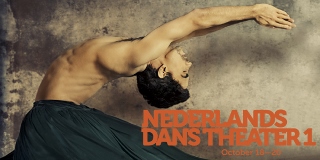PUTTING THE THEATER IN DANCE
Living up to its name, Nederlands Dans Theater 1 bounded into Los Angeles last night, showing off the reasons why The Hague-based contemporary dance outfit is known for defying convention. With a mixture of acting, multi-media, unique choreography and bravado inventiveness, this world-class company offered three works in a program that refreshingly cannot be pigeonholed into categories such as avant garde, modern, jazz or classical. Utilizing all the dance styles which have come before, artistic director Paul Lightfoot and artistic 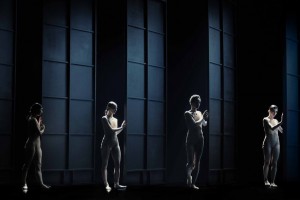 advisor Sol León (both of whom are resident choreographers as well) have ensured that the company which was founded to break from tradition continues to go where no dance has gone before.
advisor Sol León (both of whom are resident choreographers as well) have ensured that the company which was founded to break from tradition continues to go where no dance has gone before.
Opening the three-act evening at the Dorothy Chandler Pavilion was Medhi Walerski’s Chamber, a co-commission by the Music Center. Inspired by the 100th anniversary of Le Sacre du Printemps (the Joffrey reconstructed version of which appeared here last February), this fascinating work is more than an homage to composer Igor Stravinsky and choreographer Vaslav Nijinsky. Set to Joby Talbot’s thrilling new score written especially for this piece, Mr. Walerski (who had a very busy night appearing in the program’s other two pieces) displays some of the primal movement associated with Printemps’”spasms, punching, stretching, kicking, prancing, and outstretched arms’”but adds an element of the psychological underpinnings of a society peopled by those who sacrifice each other for their own good.
It’s as if the 18 dancers are in some kind of chamber and we get to witness what occurs when animal nature dominates the cerebral aspects of our beings. Walerski takes inspiration from iconic and archetypal images such as statues and creates an otherworldly reality with its own laws. The group scenes are riveting as dancers copy each other, take each other’s place, slink, fall to the ground, walk as pedestrians on a 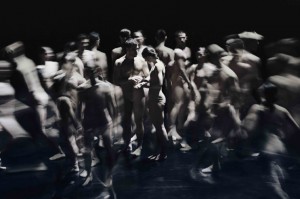 busy city street, and at one point, gather in a swirling circle taking energy from a couple within (as if to say we are all feeding off one another).
busy city street, and at one point, gather in a swirling circle taking energy from a couple within (as if to say we are all feeding off one another).
Intense savagery abounds as dancers slide in and out of a background of swiveling doors. Sometimes the stage is bare; at other times, the dancers remain still and tentative, which is especially effective when the music is harsh, threatening, clamoring, suspenseful and driving. Walerski also designed the stunning flesh-colored body-tight costumes, underwear for the men and thin gauzy material exposing the women’s breasts. Combined with Jordan Tuinman’s shadowy-low footlights which go up and down (the passing of time, perhaps?), there is a commentary highlighting how we try to remain hidden in life but see right through each other at the same time.
Don’t look for a story line in this 30-minute wonderment, or you may be confounded. Simply allow the array of dreamlike images to invade your senses and you will be richly rewarded.
I see Same Difference, set to selections from Philip Glass’s Symphony No. 3 and from his String Quartet No. 5, presenting society as a mad house. Co-choreographers León and Lightfoot have assembled a world similar in feel to Einstein on the Beach, which played last week at the Chandler. This funny, engaging and haunting work has elements of Film Noir and the Brechtian theater which evolved from German Expressionism. Via seven archetypal characters, Same Difference examines the ego and how it blocks both connection and freedom. The dancers show off their acting skills and deliver their absurd dialogue with abandon. Their speech is at times guttural and appears as 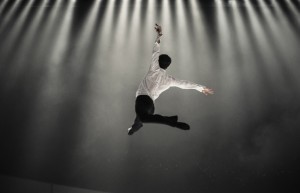 indecipherable gibberish like that of the hissing aliens in a Star Wars movie; other times we hear language, both foreign and English, such as “I am not here” and “Shut up.”
indecipherable gibberish like that of the hissing aliens in a Star Wars movie; other times we hear language, both foreign and English, such as “I am not here” and “Shut up.”
There is the fussy, patriarchal figure of The Poet (a loony Mr. Walerski), the fascist soldier (handsome and creepy Jorge Nazal), The One Who is Not (blonde-haired, light-skinned Marne van Opstal), His Shadow (a comical Bastien Zorzetto), the staunch matriarch Dona Amar-jura (played in drag by Fernando Hernando Magadan), Remedios, a female anarchist (Luisa Maria Arias), and La Maria, a desirous young woman (the ridiculously beautiful Sarah Reynolds).
I love how solo dances display each persona’s particular ego while others simply walk in character. It’s almost a master class in physical acting. The spooky and bizarre goings on include choreography typical of the evening: among classical fluid lines and jumps, are severe, small and angular movements. The septet interacts and breaks apart, traveling over a small, low-lying bridge or walking (or in the case of the soldier, slithering) into the pit (the music is taped).
A trajectory occurs during the second part, mimicking the sensual, yearning music of Glass’s String Quartet. The soldier is now an old man and all learn to drop their pretenses. This section contains the most phenomenal pas de deux of the night: Ms. Reynolds and Mr. van Opstal were classical, lyrical and altogether breathtaking. Tom Bevoort’s lighting consisted of slow-moving grids that lit the fog hovering over the stage.
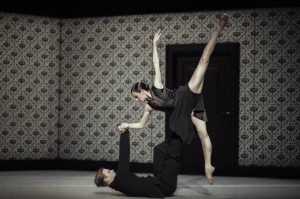 I can’t quite remember so much non-verbal dialogue being “spoken” as in Shoot the Moon, set to Movement II of Philip Glass’s Tirol Concerto for Piano and Orchestra (2000). Again León and Lightfoot bring us into a cinematic world, but this one is specifically Hitchcockian as a rotating set takes us into the intimate world of three couples (played by five dancers!). Their movement has a quality of silent movies as characters yawn, eat, argue and literally climb the walls. Video of offstage dancers is projected on two screens above the action (a close-up of an eye was my favorite), which has all three couples trying to break free from their despairing relationships into another. As the couples interact, there is consistently a new reality occurring which is not what they bargained for, and the final image of a woman’s soul disappearing into a man’s chest lingers with a poignant melancholy.
I can’t quite remember so much non-verbal dialogue being “spoken” as in Shoot the Moon, set to Movement II of Philip Glass’s Tirol Concerto for Piano and Orchestra (2000). Again León and Lightfoot bring us into a cinematic world, but this one is specifically Hitchcockian as a rotating set takes us into the intimate world of three couples (played by five dancers!). Their movement has a quality of silent movies as characters yawn, eat, argue and literally climb the walls. Video of offstage dancers is projected on two screens above the action (a close-up of an eye was my favorite), which has all three couples trying to break free from their despairing relationships into another. As the couples interact, there is consistently a new reality occurring which is not what they bargained for, and the final image of a woman’s soul disappearing into a man’s chest lingers with a poignant melancholy.
For some, the final work will resonate most (it certainly was an audience favorite based on the ovation), not just for its cleverness but also for its storytelling.
Just to avoid confusion, the “1” after NDT refers to its company of seasoned dancers with solo qualities; NDT2 is for dancers aged 17 and 22; and NDT3 is especially for dancers of 40 years and older. Regardless of the numeral following its name, Nederlands Dans Theater can safely consider itself Number One.
photos by Rahi Rezvani
Nederlands Dans Theater 1
Glorya Kaufman presents Dance at The Music Center
Dorothy Chandler Pavilion
scheduled to end on October 20, 2013
for tickets, call (213) 972-0711 or visit The Music Center
